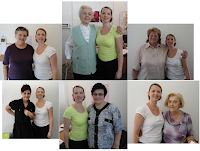I’m currently in Sarajevo with The Healing Hands Network. Having arrived late on Saturday, I’ve had a day to find my bearings, a day in the clinic and a day on outreach. So time for some initial impressions, and photos.
 |
| Market in the old town |
 |
| Reminders of the past |
I climbed a little out of the centre by the river to get a better feel for the city's situation – and it really is stunning. To the north and south, mountains rise seemingly vertically, with houses clinging on to the slopes as they rise, and eventually giving way to deep green forest.
 |
| View over the city |
 |
| The clinic in Sarajevo |
 |
| Some of the clients I've treated so far |
So, 2 days done, and 12 to go (with a break at the weekend!). I’m tired, but now I’ve got the feel for how it works I think it’ll get a bit easier. So lets see what, and who, tomorrows brings onto my couch.

